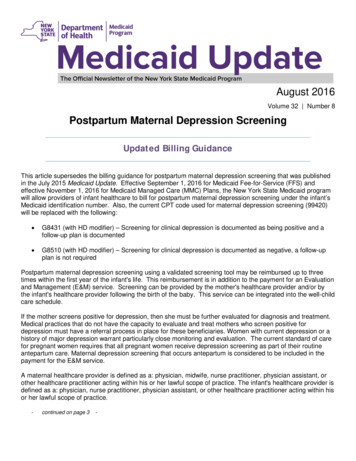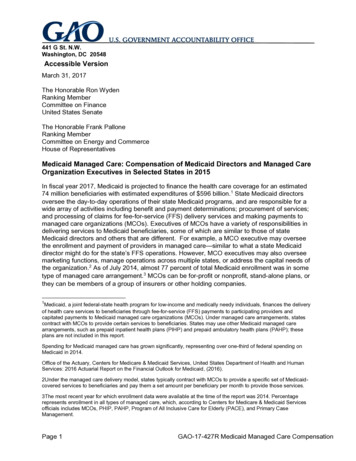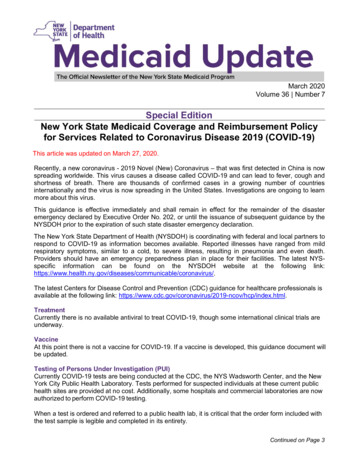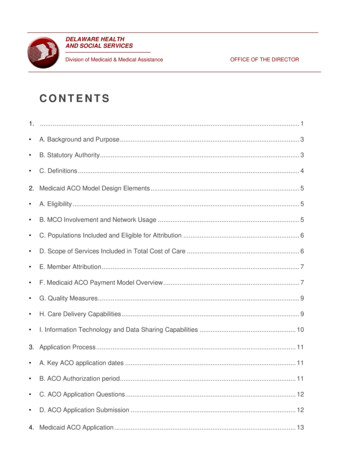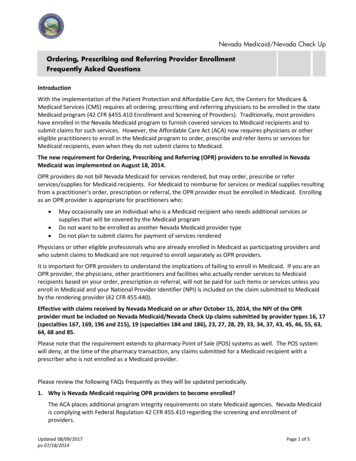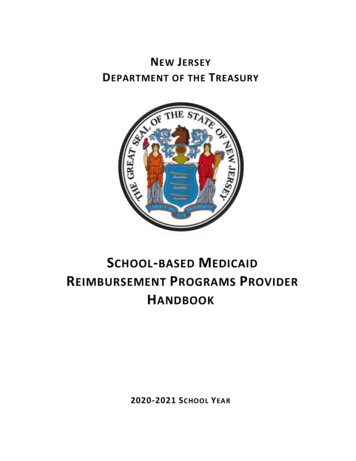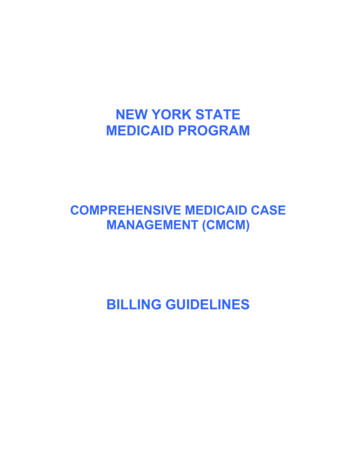
Transcription
NEW YORK STATEMEDICAID PROGRAMCOMPREHENSIVE MEDICAID CASEMANAGEMENT (CMCM)BILLING GUIDELINES
CMCM Billing GuidelinesTABLE OF CONTENTSSection I - Purpose Statement . 2Section II – Claims Submission . 3Electronic Claims. 3Paper Claims . 7Billing Instructions for CMCM Services. 10Section III – Remittance Advice . 25Electronic Remittance Advice . 25Paper Remittance Advice . 26Version 2004 – 1Page 1 of 48
CMCM Billing GuidelinesSection I - Purpose StatementThe purpose of this document is to assist the provider community in understanding andcomplying with the New York State Medicaid (NYS Medicaid) requirements andexpectations for: Billing and submitting claims. Interpreting and using the information returned in the Medicaid Remittance Advice.This document is customized for CMCM providers and should be used by the provider’sbilling staff as an instructional as well as a reference tool.Version 2004 – 1Page 2 of 48
CMCM Billing GuidelinesSection II – Claims SubmissionCMCM providers can submit their claims to NYS Medicaid in electronic or paperformats.Electronic ClaimsPursuant to the Health Insurance Portability and Accountability Act (HIPAA), Public Law104-191, which was signed into law August 12, 1996, the NYS Medicaid Programadopted the HIPAA-compliant transactions as the sole acceptable format for electronicclaim submission, effective November 2003.CMCM providers who choose to submit their Medicaid claims electronically are requiredto use the HIPAA 837 Institutional (837I) transaction. In addition to this document,direct billers may also refer to the sources listed below to comply with the NYS Medicaidrequirements. HIPAA 837I Implementation Guide (IG) – A document that explains the proper use ofthe 837I standards and program specifications. This document is available atwww.wpc-edi.com/hipaa. NYS Medicaid 837I Companion Guide (CG) – A subset of the IG, which providesinstructions for the specific requirements of NYS Medicaid for the 837I. Thisdocument is available at www.nyhipaadesk.com.Under the News and Resources tab:Select eMedNY Phase II HIPAA Transactions from the menu (click on the box).Click on 837 Institutional Health Care Claim Transaction.Click on Companion Guide-837. NYS Medicaid Supplemental Companion Guide – This document provides technicalinformation needed to successfully transmit and receive electronic data. Some of thetopics put forth in this CG are testing requirements, error report information, andcommunication specifications. The Supplemental Companion Guide is available atwww.nyhipaadesk.com.Under the News and Resources tab:Select eMedNY Phase II HIPAA Transactions from the menu (click on the box).Version 2004 – 1Page 3 of 48
CMCM Billing GuidelinesClick on 837 Institutional Health Care Claim Transaction.Click on Supplemental Companion Guide.Pre-requirements for the Submission of Electronic ClaimsBefore being able to start submitting electronic claims to NYS Medicaid, providers needthe following: An Electronic Transmitter Identification Number (ETIN) A Certification Statement A User ID and Password A Trading Partner Agreement TestingETINThis is a four-character submitter identifier, issued by the NYS Medicaid Fiscal Agentupon application and that must be used in every electronic transaction submitted toNYS Medicaid. ETINs may be issued to an individual provider or provider group (if theyare direct billers) and to service bureaus or clearinghouses.ETIN applications are available at www.emedny.org.Under Information:Click on Provider Enrollment FormsClick on Electronic Transmitter Identification NumberCertification StatementAll providers, either direct billers or those who billed through a service bureau orclearinghouse, must file a notarized Certification Statement with NYS Medicaid for eachETIN used for the electronic billing.The Certification Statement is good for one year, after which it needs to be renewed forelectronic billing continuity under a specific ETIN. Failure to renew the CertificationStatement for a specific ETIN will result in claim rejection.The Certification Statement is available at www.emedny.org together with the ETINapplication.Version 2004 – 1Page 4 of 48
CMCM Billing GuidelinesUser ID and PasswordElectronic submitters need a user ID and password to access the NYS MedicaideMedNY system through one of the communication methods available. The user IDand password are issued to the submitter at the time of enrollment in one of thecommunication methods.Trading Partner AgreementThis document addresses certain requirements applicable to the electronic exchange ofinformation and data associated with health care transactions. The NYS MedicaidTrading Partner Agreement is available at www.emedny.org.From the Menu:Select HIPAAClick on NYS Medicaid Trading Partner Information and FormsClick on Trading Partner Agreement FormTestingDirect billers (either individual providers or service bureaus/clearinghouses that bill formultiple providers) are encouraged to submit production tests to CSC before they startsubmitting Medicaid claims for the first time after enrollment or any time they updatetheir systems or start using a new system. This testing will assist providers inidentifying errors in their system and allow for corrections before they submit actualclaims.Information and instructions regarding testing are available at www.emedny.org.Under Information:Click on eMedNY Phase IIClick on eMedNY Provider Testing Users GuideCommunication MethodsThe following communication methods are available for submission of electronic claimsto NYS Medicaid: eMedNY eXchange FTPVersion 2004 – 1Page 5 of 48
CMCM Billing Guidelines CPU to CPU eMedNY GatewayeMedNY eXchangeThe eMedNY eXchange works like email; users are assigned an inbox and they areable to send and receive transaction files in an email-like fashion. Transaction files areattached and sent to eMedNY for processing and the responses are delivered to theuser’s inbox so they can be detached and saved on the user’s computer. For securityreasons, the eMedNY eXchange is accessible only through the eMedNY websitewww.emedny.org.The eMedNY eXchange only accepts HIPAA-compliant transactions.Procedures and instructions regarding how to enroll in the eMedNY eXchange areavailable at www.emedny.org.Under Information:Click on eMedNY Phase IIClick on eMedNY Provider Testing User GuideOn the table of Contents, click on OverviewScroll down to Access MethodsFTPFTP allows for direct or dial-up connection.CPU to CPU (FTP)This method consists of an established direct connection between the submitter and theprocessor and it is most suitable for high volume submitters.eMedNY GatewayThis is a dial-up access method. It requires the use of the User ID assigned at the timeof enrollment and a password.Note: For questions regarding FTP, CPU to CPU or eMedNY Gatewayconnections, call CSC-Provider Enrollment Support at 800-343-9000.ePACESAdditionally, NYS Medicaid provides ePACES, a HIPAA-compliant web-basedapplication that is customized for specific transactions, including the 837I. ePACES,Version 2004 – 1Page 6 of 48
CMCM Billing Guidelineswhich is provided free of charge, is ideal for providers with small-to-medium claimvolume.To take advantage of ePACES, providers need to follow an enrollment process, which isavailable at www.emedny.org. Providers who enroll in ePACES will be automaticallyenrolled in eMedNY eXchange.The requirements for using ePACES include: An ETIN and Certification Statement should be obtained prior to enrollment Internet Explorer 4.01 and above or Netscape 4.7 and above Internet browser that supports 128-bit encryption and cookies Minimum connection speed of 56K An accessible email addressThe following transactions can be submitted via ePACES: 270/271 - Eligibility Benefit Inquiry and Response 276/277 - Claim Status Request and Response 278 - Prior Approval/Prior Authorization/Service Authorization Request and Response 837 - Dental, Professional, and Institutional ClaimsPaper ClaimsCMCM providers who choose to submit their claims on paper forms must use the CMSstandard UB-92 claim form. A link to this form appears at the end of this subsection.General Instructions for Completing Paper ClaimsSince the information entered on the claim form is captured via an automated datacollection process (imaging), it is imperative that it be legible and placed appropriately inthe required fields. The following guidelines will help ensure the accuracy of theimaging output: All information should be typed or printed. Alpha characters (letters) should be capitalized.Version 2004 – 1Page 7 of 48
CMCM Billing Guidelines Numbers should be written as close to the example below as possible:123456789 Circles (the letter O, the number 0) must be closed. Avoid unfinished characters. For example:Written As6. 0 06.00Interpreted As6.60 Zero interpreted as sixWhen typing or printing, stay within the box and within the hash marks whereprovided; ensure that no characters (letters or numbers) touch the claim form lines.For example:Written As Intended As0Intended AsInterpreted As227332 Two interpreted as sevenThree interpreted as twoCharacters should not touch each other. Example:Written As23Intended As23Interpreted Asillegible Entry cannot beinterpreted properly Do not write between lines. Do not use arrows or quotation marks to duplicate information. Do not use the dollar sign ( ) to indicate dollar amounts; do not use commas toseparate thousands. For example, three thousand should be entered as 3000, not as3,000. For writing, it is best to use a felt tip pen with a fine point. Avoid ballpoint pens thatskip; do not use pencils, highlighters, or markers. Only blue or black ink isacceptable. If filling in information through a computer, ensure that all information is alignedproperly, and that the printer ink is dark enough to provide clear legibility.Version 2004 – 1Page 8 of 48
CMCM Billing Guidelines Do not submit claim forms with corrections, such as information written overcorrection fluid or crossed out information. If mistakes are made, a new form shouldbe used. Separate forms using perforations; do not cut the edges. Do not fold the claim forms. Do not use adhesive labels (for example for address); do not place stickers on theform. Do not write or use staples on the bar-code area.If submitting multiple claim forms, they may be batched up to 100 forms per batch. Usepaper clips or rubber bands to hold the claim forms in each batch together. Do not usestaples.For mailing completed claim forms, use the self-addressed envelopes provided by CSCfor this purpose. For information on how to order envelopes please refer to Informationfor All Providers, Inquiry section on this web page. The address for submitting claimforms is:COMPUTER SCIENCES CORPORATIONP.O. Box 4601Rensselaer, NY 12144-4601UB-92 Claim FormTo view the UB-92 claim form please click on the link provided below. The displayedclaim form is a sample and the information it contains is for illustration purposes only.Claim Sample-UB92NR CMCMGeneral Information About the UB-92 FormThe UB-92 HCFA-1450 is a CMS standard form; therefore CSC does not supply it.These forms can be obtained from any of the national suppliers.The UB-92 Manual (National Uniform Billing Data Element Specifications as Developedby the National Uniform Billing Committee – Current Revision) should be used inconjunction with this Provider Manual as a reference guide for the preparation of claimsto be submitted to NYS Medicaid.The UB-92 Form Locators listed below have no NYS Medicaid application; thereforeinstructions for these fields are not provided in this document.Version 2004 – 1Page 9 of 48
CMCM Billing GuidelinesForm Locators2, 5, 10, 11, 13, 16-18, 20, 21, 23, 31, 36, 38, 44, 45, 48, 49, 52-59, 61, 62, 64-66, 7681, and 84.Billing Instructions for CMCM ServicesThis subsection of the Billing Guidelines covers the specific NYS Medicaid billingrequirements for CMCM providers. Although the instructions that follow are based onthe UB-92 paper claim form, they are also intended as a guideline for electronic billerswho should refer to these instructions for finding out what information they need toprovide in their claims, what codes they need to use, etc.It is important that providers adhere to the instructions outlined below. Claims that donot conform to the eMedNY requirements as described throughout this document maybe rejected, pended, or denied.Field-by-Field (UB-92) InstructionsPROVIDER NAME, ADDRESS, AND TELEPHONE NUMBER (Form Locator 1)Enter the billing provider’s name and address.Note: It is the responsibility of the provider to notify Medicaid of any change ofaddress or other pertinent information within 15 days of the change. Forinformation on where to direct address change requests please refer toInformation for All Providers, Inquiry section.PATIENT CONTROL NO. (Form Locator 3)For record-keeping purposes, the provider may choose to identify a recipient by usingan account/patient control number. This field can accommodate up to 20 alphanumericcharacters. If an account/patient control number is indicated on the claim form, it will bereturned on the Remittance Advice. Using an account/patient control number can behelpful for locating accounts when there is a question on recipient identification.TYPE OF BILL (Form Locator 4)Completion of this field is required for all provider types. All entries in this field mustcontain three digits. Each digit identifies a different category as follows: 1st Digit – Type of Facility 2nd Digit – Bill ClassificationVersion 2004 – 1Page 10 of 48
CMCM Billing Guidelines 3rd Digit – FrequencyType of FacilityEnter the value 3 (Home Health) as the first digit of this field. The source of this code isthe UB-92 Manual, Form Locator 4, Type of Facility category.Bill ClassificationEnter the value 4 (Other) as the second digit of this field. The source of this code is theUB-92 Manual, Form Locator 4, Bill Classification (Except Clinics and Special Facilities)category.Example:4 TYPEOF BILL34XFrequency - Adjustment/Void CodeNew York State Medicaid uses the third position of this field only to identify whether theclaim is an original, a replacement (adjustment) or a void. If submitting an original claim, enter the value 0 in the third position of this field.Example:4 TYPEOF BILL340 If submitting an adjustment (replacement) to a previously paid claim, enter the value 7in the third position of this field.Example:4 TYPEOF BILL347 If submitting a void to a previously paid claim, enter the value 8 in the third position ofthis field.Example:4 TYPEOF BILL348STATEMENT COVERS PERIOD FROM/THROUGH (Form Locator 6)Enter the date(s) of service claimed in accordance with the instructions provided below. If the billing rate allows multiple units of service (hours, hour fractions, visits, etc.) perday, only one date of service can be billed per claim form. When billing for one dateof service, enter the date in the FROM box. The THROUGH box may contain thesame date or may be left blank.Version 2004 – 1Page 11 of 48
CMCM Billing Guidelines If the billing rate allows only one unit of service (hour, hour fraction, visit, etc.) perday, multiple dates of service can be billed on the same claim form. When billing formultiple services dates, enter the first service date of the billing period in the FROMbox and the last service date in the THROUGH box. If billing for monthly rates, only one date of service can be billed per claim form.Enter the date in the FROM box. The THROUGH box may contain the same date ormay be left blank.Dates must be entered in the format MMDDYYYY.Special Instructions for ICM/CMCM OnlyEnter the first day of the month subsequent to the month in which services wererendered in the FROM box unless the patient loses Medicaid eligibility during theservice month. If the patient loses eligibility before the first of the month subsequent tothe service month, enter the date on which the last of the required four face-to-faceencounters took place. Providers should verify patient eligibility through MEVS in orderto ensure payment for their services.Only one ICM claim can be submitted per claim form.Note: Claims must be submitted within 90 days of the earliest date (FROM date)entered in this field.COV D. [Covered Days] (Form Locator 7)Leave this field blank.N-CD. [Non-Covered Days] (Form Locator 8)Leave this field blank.C-ID. [Coinsurance Days] (Form Locator 9)Leave this field blank.PATIENT NAME (Form Locator 12)Enter the patient’s last name followed by the first name as they appear on the CommonBenefit Identification Card.BIRTHDATE (Form Locator 14)Enter the patient’s birth date indicated on the Common Benefit Identification Card. Thebirth date must be in the format MMDDYYYY.Version 2004 – 1Page 12 of 48
CMCM Billing GuidelinesExample: Mary Brandon was born on March 23, 1976. Enter the birth date as03231976.14 BIRTHDATE03231976SEX (Form Locator 15)Enter M for male or F for female to indicate the patient’s sex.ADMISSION TYPE (Form Locator 19)Leave this field blank.STAT [Patient Status] (Form Locator 22)This field is used to indicate the specific condition or status of the patient as of the lastdate of service indicated in Form Locator 6. Select the appropriate code (except for 43and 65) from the UB-92 Manual.CONDITION CODES (Form Locators 24–30)NYS Medicaid uses Condition Codes to indicate the following: EPSDT/CTHP Family Planning Possible Disability Abortion/SterilizationNote: EPSDT/CTHP and Abortion Sterilization do not apply to CMCM claims.Family Planning – A4If applicable, enter Condition Code A4 to indicate that the claim relates to familyplanning.Under CMCM, the case manager does not provide medical family planning servicessuch as diagnosis, treatment, drugs, supplies and related counseling. These servicesare furnished, prescribed by, or administered under the supervision of a physician. Forthe purpose of CMCM billing, except programs with monthly rates, services related tofamily planning are those that the case manager offers and arranges for to enableindividuals to plan their families in accordance with their wishes. CMCM family planningVersion 2004 – 1Page 13 of 48
CMCM Billing Guidelinesservices include, but are not limited to: Disseminating information either orally or in writing about available family planninghealth services; Providing for individual or group discussion regarding the need for family planninghealth services; Providing assistance in accessing services by arranging visits with medical familyplanning providers.Possible Disability – A5If applicable, enter Condition Code A5 to indicate that the patient’s condition appearedto be of a disabling nature.If neither Family Planning nor Possible Disability are applicable conditions, leave thisfield blank.OCCURRENCE CODE/DATE (Form Locators 32–35)NYS Medicaid uses Occurrence Codes to report Accident Code.This field has two components: Code and Date; both are required when applicable.CodeIf applicable, enter the appropriate Accident Code to indicate whether the servicerendered to the patient was for a condition resulting from an accident or crime. Selectthe code from the UB-92 Manual, Form Locators 32-35, Accident Related Codes.DateIf an entry was made under Code, enter the date when the accident occurred in theformat MMDDYY.UNLABELED [Transaction Control Number (TCN)] (Form Locator 37A, B, C)If submitting an Adjustment (Replacement) or a Void to a previously paid claim, thisfield must be used to enter the TCN assigned to the claim to be adjusted or voided. TheTCN is the claim identifier and is listed in the Remittance Advice. If a TCN is entered inthis field, the third position of Form Locator 4, Type of Bill, must be 7 or 8.The TCN must be entered on the line (A, B, or C) that matches the line assigned toMedicaid in Form Locators 50 and 51. If the TCN is entered in lines B or C, the wordNONE must be written on the line(s) above the TCN line.When submitting an original claim, leave this field blank.Version 2004 – 1Page 14 of 48
CMCM Billing GuidelinesAdjustmentsAn adjustment is submitted to correct one or more fields of a previously paid claim. Anyfield, except the Provider ID number or the Patient’s Medicaid ID number, can beadjusted. The adjustment must be submitted in a new claim form (copy of the originalform is unacceptable) and all applicable fields must be completed. An adjustment isidentified by the value 7 in the third position of Form Locator 4, Type of Bill, and theclaim to be adjusted is identified by the TCN entered in this field (Form Locator 37).Adjustments cause the correction of the adjusted information in the claim historyrecords as well as the cancellation of the original claim payment and the re-pricing ofthe claim based on the adjusted information.VoidsA void is submitted to nullify a paid claim. The void must be submitted in a new claimform (copy of the original form is unacceptable) and all applicable fields must becompleted. A void is identified by the value 8 in the third position of Form Locator 4,Type of Bill, and the claim to be voided is identified by the TCN entered in this field(Form Locator 37).Voids cause the cancellation of the original claim history records and payment.VALUE CODES (Form Locators 39–41)NYS Medicaid uses Value Codes to report the following information: Locator Code (required) Rate Code (required) Medicare Information (only if applicable) Other Insurance Payment (only if applicable) Patient Participation/Spend-down (only if applicable)Value Codes have two components: Code and Amount. The Code component is usedto indicate the type of information reported. The Amount component is used to enterthe information itself. Both components are required for each entry.Locator Code – Value Code 61Locator codes are assigned to the provider for each service address registered at thetime of enrollment in the Medicaid program or at anytime, afterwards, that a newlocation is added.Value CodeVersion 2004 – 1Page 15 of 48
CMCM Billing GuidelinesCode 61 should be used to indicate that a Locator Code is entered under Amount.Value AmountEntry must contain three digits and must be placed to the left of the dollars/centsdelimiter.Currently Locator codes are issued as two-digit codes. However, any entry in this fieldmust have three digits. Therefore, providers need to enter an additional zero to the leftof these two-digit codes to comply with eMedNY billing requirements. For example,locator code 03 must be entered as 003, etc.Locator codes 001 and 002 are for administrative use only and are not to be entered inthis field. If the provider renders services at one location only, enter locator code 003.If the provider renders service to Medicaid recipients at more than one location, theentry may be 003 or a higher locator code. Enter the locator code that corresponds tothe address where the service was performed.The example below illustrates a correct Locator Code entry.39Example:CODEa61VALUE CODESAMOUNT003 b c d Note: The provider is reminded of the obligation to notify Medicaid of all servicelocations as well as changes to any of them. For information on where to directLocator Code updates, please refer to Information for All Providers, Inquirysection on this web page.Rate Code – Value Code 24Rates are established by the Department of Health and other State agencies. At thetime of enrollment in Medicaid, providers receive notification of the rate codes and rateamounts assigned to their category of service. Any time that rate codes or amountschange, providers also receive notification from the Department of Health.Value CodeCode 24 should be used to indicate that a rate code is entered under Amount.Value AmountEnter the rate code that applies to the service rendered. The four-digit rate code mustbe entered to the left of the dollars/cents delimiter.Version 2004 – 1Page 16 of 48
CMCM Billing GuidelinesThe example below illustrates a correct Rate Code entry.39Example:CODEa24VALUE CODESAMOUNT5200 b c d Rate Code Special Instructions ICM/CMCM OnlyThe ICM rate code (5200) is a monthly rate representing a minimum of four face-toface encounters with the patient within a calendar month. SCM/CMCM OnlyThe SCM rate codes - 5205 and 5206 - are monthly rates representing a minimumof two face-to-face encounters with the patient within a calendar month. Blended/CMCM OnlyThe Blended rate codes - 5250 through 5259 – are monthly rates representing anaggregate minimum number of face-to-face encounters with patients within acalendar month. The minimum number of face-to-face encounters is based on theconfiguration of the Blended Team. The minimum encounters for each type ofteam will be based on a schedule provided to Blended Case Managementprograms by the NYS Office of Mental Health. OMRDD/CMCM OnlyFor the OMRDD rate code (5221), a minimum of one monthly encounter per case isrequired in all cases except for patients residing with their families; in that case, aminimum of one quarterly encounter may be maintained instead, if: The patient is a child who attends a residential school during the school termand requires intensive case management services only part of the year; or The family has requested less frequent contact and the case managerdetermines that this is appropriate.Medicare Information (See Value Codes Below)If the recipient is also a Medicare beneficiary, it is the responsibility of the provider todetermine whether the service being billed for is covered by the recipient's Medicarecoverage. If the service is covered or if the provider does not know if the service iscovered, the provider must first submit a claim to Medicare, as Medicaid is always theVersion 2004 – 1Page 17 of 48
CMCM Billing Guidelinespayer of last resort.Value Code If applicable, enter the appropriate code, as listed below, to indicate that one (ormore) of the following items is entered under Amount. Medicare Deductible – A1 or B1 Medicare Co-insurance – A2 or B2 Medicare Co-payment – A7 or B7Enter code A3 or B3 to indicate that the Medicare Payment is entered under Amount.Note: The line (A or B) assigned to Medicare in Form Locator 50 determines thechoice of codes AX or BX.Value Amount Enter the corresponding amount for each value code entered. Enter the amount that Medicare actually paid for the service. If Medicare deniedpayment or if the provider knows that the service would not be covered by Medicare,or has received a previous denial of payment for the same service, enter 0.00.Proof of denial of payment must be maintained in the patient's billing record.Other Insurance Payment – Value Code A3 or B3If the recipient has insurance other than Medicare, it is the responsibility of the providerto determine whether the service being billed for is covered by the recipient's OtherInsurance carrier. If the service is covered or if the provider does not know if the serviceis covered, the provider must first submit a claim to the Other Insurance carrier, asMedicaid is always the payer of last resort.Value CodeIf applicable, code A3 or B3 should be used to indicate that the amount paid by aninsurance carrier other than Medicare is entered under Amount. The line (A or B)assigned to the Insurance Carrier in Form Locator 50 determines the choice of codesA3 or B3.Value AmountEnter the actual amount paid by the other insurance carrier. If the other insurancecarrier denied payment enter 0.00. Proof of denial of payment must be maintained inthe patient’s billing record. Zeroes must also be entered in this field if any of thefollowing situations apply: Prior to billing the insurance company, the provider knows that the service will not beVersion 2004 – 1Page 18 of 48
CMCM Billing Guidelinescovered because: The provider has had a previous denial for payment for the service from theparticular insurance policy. However, the provider should be aware that theservice should be billed if the insurance policy changes. Proof of denialsmust be maintained in the patient’s billing record. Prior claims denied due todeductibles not being met are not to be counted as denials for subsequentbillings. In very limited situations the Local Department of Social Services (LDSS) hasadvised the provider to zero-fill the Other Insurance payment for the sametype of service. This communication should be documented in the client'sbilling record.The provider bills the insurance company and receives a rejection because: The service is not covered; or The deductible has not been met. The provider cannot directly bill the insurance carrier and the policyholder is eitherunavailable or uncooperative in submitting claims to the insurance company. In thesecases the LDSS must be notified prior to zero-filling. Since June 1, 1992, the LDSShas subrogation rights enabling it to complete claim forms on behalf of uncooperativepolicyholders who do not pay the provider for the services. The LDSS can direct theinsurance company to pay the provider directly for the service whether or not theprovider participates with the insurance plan. The provider should contact the thirdparty worker in the LDSS whenever he/she encounters policyholders who areuncooperative in paying for covered services received by their dependents who areon Medicaid. In other cases providers will be instructe
COMPUTER SCIENCES CORPORATION P.O. Box 4601 Rensselaer, NY 12144-4601 UB-92 Claim Form To view the UB-92 claim form please click on the link provided below. The displayed claim form is a sample and the information it contains is for illustration purposes only. Claim Sample-UB92NR CMCM General Information About the UB-92 Form


